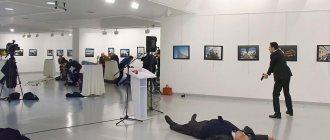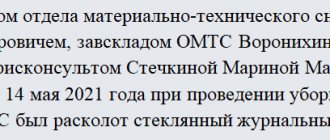When checking written work in the Russian language, the teacher not only corrects errors, but also indicates their type in the margins. It is the nature of the errors that these strange dashes, checkmarks and other squiggles indicate. Such a system allows the teacher to easily determine what grade to give to the student, and the teacher himself to understand why his grade was lowered and what rules need to be worked on. Today we will talk about what mistakes there are in the Russian language. I will classify them with examples in a convenient tabular form and help you decipher the mysterious signs that literature teachers leave in the margins of notebooks with written work on the Russian language.
Types of errors in Russian
| Symbol | Error type | Explanation | Examples |
| I | Orthographic | Errors in the spelling of words (in roots, prefixes, endings), including in the placement of hyphens, in continuous and separate spelling. | Somehow (correct: somehow), exams (correct: exams), in a fur coat (correct: in a fur coat), ran away (correct: ran away). |
| V | Punctuation | Errors in the placement of punctuation marks (incorrect choice of punctuation mark, its absence in the right place or its presence where it is not needed). | The boy crouched under the branches of a tree and ran home - where his father, who had arrived from a business trip, was waiting for him. (The boy, bending down, crawled under the branches of the tree and ran home, where his father, who had arrived from a business trip, was waiting for him.) |
| G | Grammar | Errors in the formation of words and their forms, as well as in their choice (incorrect agreement in numbers, cases). | The most beautiful (the most beautiful or the most beautiful), the richer (richer), in accordance with the decree (according to the decree), payment for travel (payment for travel or fare). |
| R | Speech | Errors in the use of vocabulary (including paronyms, homonyms, synonyms), including tautology. | Diploma of the competition (diploma of the competition), price list (price list or prices). |
| WITH | Stylistic | Use of vocabulary that has an inappropriate stylistic coloring (usually colloquial, slang). Can be considered a type of speech error. | And then the main character of the story went crazy (that’s right: he made a mistake). This episode is cool (interesting, memorable). |
| Z | Violation of paragraph division of text | The text is incorrectly divided into micro-topics or paragraphs are not highlighted at all. | |
| F | Actual | The content of the text is distorted (when writing an exposition or essay) | Dubrovsky met Masha when he was robbing Troekurov (as it actually happened, I told you earlier). |
| L | Logical | Errors in the logical construction of the text (usually they are associated with a violation of the cause-and-effect relationship). This also includes syntactic errors that lead to a distortion of the meaning or its double interpretation. | Dubrovsky was a noble robber, so he decided not to rob Troekurov. (Dubrovsky was a noble robber, so he, having fallen in love with Masha Troekurova, decided not to rob her father.) There are many works about love in Russian literature. (There are many works about love in Russian literature.) |
Schoolchildren and their parents rarely have doubts about what kind of punctuation or spelling error was made in written work on the Russian language. Everything can be seen from the teacher’s corrections. But if speech, grammatical, logical and factual errors are detected in the work, questions arise.
The Federal Institute of Pedagogical Measurements (FIPI) has developed recommendations for language teachers checking students' test papers on the classification of errors that occur in these papers. You can download a classifier table with examples from the link.
Below you will find a brief description of typical errors, compiled on the basis of the “Methodological materials for chairmen and members of subject commissions of the constituent entities of the Russian Federation on checking the completion of tasks with a detailed answer of the Unified State Examination papers” and “Methodological recommendations for preparing for the final essay”. The last document concerns creative work (essays, presentations) that students complete in the winter for admission to the Unified State Exam.
Lesson technology
Recommendations for qualifying errors when checking final essays (presentations)
When checking an essay (presentation), the following types of errors are taken into account:
- inconsistency of the content of the essay with the topic or substitution of the topic;
- factual errors associated with the writer’s lack of reliable information on the topic under discussion, ignorance (or poor knowledge) of the texts of works of art, historical-literary and cultural-historical context, incorrect or inaccurate use of terms and concepts;
- logical errors associated with violation of the laws of logic both within one sentence, judgment, and within the whole text, for example: comparison (contrast) of concepts that are different in scope and content, the use of mutually exclusive concepts, substitution of one judgment for another, unreasonable opposition, establishment of incorrect cause-and-effect relationships, inconsistency of the argumentation with the stated thesis; incorrect formation of counterarguments; lack of connection between the formulated problem and the expressed opinion in connection with the problem identified in the essay; non-use or incorrect use of logical communication means, incorrect division of text into paragraphs;
- speech (including stylistic) errors, violation of the stylistic unity of the text;
- grammatical errors;
- spelling and punctuation errors;
- failure to comply with the required volume.
Online
The material offered below is not exhaustive, but can help the teacher identify the most typical mistakes made by graduates in their essays (presentations). Errors related to the content and logic of the work of online films Factual errors Violation of the requirement of reliability in the transmission of factual material causes factual errors, which are a distortion of the situation depicted in the statement or its individual details. There are two categories of factual errors.
1. Factual errors associated with the use of literary material (distortion of historical and literary facts, incorrect naming of characters, incorrect designation of the time and place of an event; errors in conveying the sequence of actions, in establishing the causes and consequences of events, etc.); incorrect indication of the date of the writer’s life or the time of creation of a work of art, incorrect designations of toponyms, errors in the use of terminology, incorrectly named genres, literary movements and movements, etc.
2. Errors in background material - various types of distortions of facts not related to the literary material. Factual errors can be divided into gross and non-gross. If the examinee claims that the author of “Eugene Onegin” is Lermontov, or calls Tatyana Larina Olga, these are gross factual errors. If, instead of “Princess Mary”, the graduate wrote “Princess Mary”, then this error can be assessed by the expert as a factual inaccuracy or typo and not taken into account when evaluating the work.
Logical errors
A logical error is a violation of the rules or laws of logic, a sign of the formal inconsistency of definitions, reasoning, evidence and conclusions. Logical errors include a wide range of violations in the construction of a detailed monologue on a given topic, ranging from deviations from the topic, omission of necessary parts of the work, lack of connection between parts and ending with individual logical inconsistencies in the interpretation of facts and phenomena. Typical logical errors of examinees include: 1) violation of the sequence of statements; 2) lack of connection between parts of the utterance; 3) unjustified repetition of a previously expressed thought; 4) fragmentation of a micro-theme by another micro-theme; 5) disproportionality of parts of the statement; 6) absence of necessary parts of the statement, etc.; 7) violation of cause-and-effect relationships; violation of the logical-compositional structure of the text. The text is a group of sentences that are closely interrelated in meaning and grammatically, revealing one micro-topic. The text, as a rule, has the following logical-compositional structure: beginning (beginning of thought, formulation of the topic), middle part (development of thought, topic) and ending (summarizing). It should be noted that this composition is typical, typical, but not mandatory. Depending on the structure of the work or its fragments, texts without any of these components are possible. The text, unlike a single sentence, has a flexible structure, so when constructing it there is some freedom in choosing forms. However, it is not unlimited. When writing an essay, it is necessary to logically and reasonably construct a monologue statement and make generalizations.
2) lack of connection between parts of the utterance; 3) unjustified repetition of a previously expressed thought; 4) fragmentation of a micro-theme by another micro-theme; 5) disproportionality of parts of the statement; 6) absence of necessary parts of the statement, etc.; 7) violation of cause-and-effect relationships; violation of the logical-compositional structure of the text. The text is a group of sentences that are closely interrelated in meaning and grammatically, revealing one micro-topic. The text, as a rule, has the following logical-compositional structure: beginning (beginning of thought, formulation of the topic), middle part (development of thought, topic) and ending (summarizing). It should be noted that this composition is typical, typical, but not mandatory. Depending on the structure of the work or its fragments, texts without any of these components are possible. The text, unlike a single sentence, has a flexible structure, so when constructing it there is some freedom in choosing forms. However, it is not unlimited. When writing an essay, it is necessary to logically and reasonably construct a monologue statement and make generalizations.
Examples of logical errors in different parts of the text
Unsuccessful beginning The text begins with a sentence containing an indication of the previous context, which is absent in the text itself, for example: This episode is described with particular force in the novel... The presence of demonstrative word forms in these sentences refers to the previous text, thus the sentences themselves cannot serve as the beginning of the composition . Errors in the middle part 1. In one sentence relatively distant thoughts come together, for example: She showed great, passionate love for her son Mitrofanushka and fulfilled all his whims. She mocked the serfs in every possible way; like a mother, she took care of his upbringing and education. 2. There is no consistency in thoughts, the order of sentences is disrupted, which leads to incoherence, for example: From Mitrofanushka, Prostakova raised an ignorant rude person. The comedy "Undergrown" is of great importance these days. In comedy, Prostakova is a negative type. Or: In his work “The Minor,” Fonvizin shows the landowner Prostakova, her brother Skotinin and the serfs. Prostakova is a powerful and cruel landowner. Her estate was taken into custody. 3. Sentences of different types in structure are used, which leads to difficulty understanding the meaning, for example: The general rise of the area above sea level determines the severity and harshness of the climate. Cold, little snowy winters followed by hot summers. Spring is short with a quick transition to summer. Correct option: The general rise of the area above sea level determines the severity and harshness of the climate. Cold winters with little snow give way to short springs, which quickly turn into hot summers. 4. The examinee does not distinguish between cause and effect, part and whole, related phenomena and other relationships, for example: Since Oblomov is a lazy person, he had Zakhar, his servant. Unsuccessful ending Conclusion duplicated: So, Prostakova loves her son ardently and passionately, but with her love she harms him. Thus, Prostakova, with her blind love, brings up laziness, promiscuity and heartlessness in Mitrofanushka. Errors associated with violation of speech, grammatical, spelling and punctuation norms When checking and evaluating the final essay (presentation), the graduate’s literacy is taken into account. The material below will help you qualify different types of errors.
Speech errors
A speech (including stylistic) error is an error not in the construction, not in the structure of a linguistic unit, but in its use, most often in the use of a word. These are mainly violations of lexical norms, for example: Stolz is one of the main characters in Goncharov’s novel of the same name “Oblomov”; They lost their only two sons in the war. The word eponymous (or unique) itself does not contain an error; it is only used poorly, does not “fit” into the context, and does not fit in meaning with its immediate surroundings. Speech (including stylistic) errors include: 1) using a word in a meaning that is unusual for it; 2) the use of foreign words and expressions; 3) inappropriate use of expressive, emotionally charged means; 4) unmotivated use of dialect and colloquial words and expressions; 5) a mixture of vocabulary from different historical eras; 6) violation of lexical compatibility (words in the Russian language are combined with each other depending on their meaning; on the traditions of use caused by language practice (words with limited compatibility); 7) the use of an extra word (pleonasm); repetition or double use of synonyms that are close in meaning in a verbal text without justified necessity (tautology); 9) unjustified omission of a word; 10) poverty and monotony of syntactic structures; 11) word order, leading to an ambiguous understanding of the sentence. Distinguishing between types of speech (including stylistic) errors is especially important when assessing works of excellent and good level. At the same time, it should be remembered that maintaining unity of style is the highest achievement of a writer. Therefore, individual stylistic errors made by schoolchildren are proposed to be considered stylistic defects . Speech errors should be distinguished from grammatical errors (see below for more on this). The testing revealed the following speech errors: violations associated with underdeveloped speech: pleonasm, tautology, speech cliches, unmotivated use of colloquial vocabulary, dialectisms, jargon; unsuccessful use of expressive means, clericalism, non-distinction (mixing) of paronyms, errors in the use of homonyms, antonyms, synonyms, polysemy not eliminated by the context. The most common errors include the following: 1. Non-distinction (mixing) of paronyms: Predatory (instead of predatory) destruction of forests led to the formation of ravines; At the end of the meeting, the floor was introduced (instead of given) to a famous scientist; In such cases, I look in the “Philosophical Dictionary” (the verb look usually has an addition with the preposition on: to look at someone or something, and the verb look, which must be used in this sentence, has an addition with the preposition c) . 2. Errors in choosing a synonym: The name of this poet is familiar in many countries (instead of the word known in the sentence, its synonym familiar is mistakenly used); Now in our press a significant space is allocated for advertising, and this does not appeal to us (in this case, instead of the word space, it is better to use its synonym place; the foreign language word impresses also requires a synonymous replacement). 3. Errors when using antonyms in constructing an antithesis: In the third part of the text, a motive that is not cheerful, but not a major one, makes us think (the antithesis requires clarity and accuracy in comparing contrasting words, and not cheerful and major are not even contextual antonyms, since they do not express multipolar manifestations of the same trait). 4. Lexical compatibility disorder: This bookstore has very cheap prices; Leonid completed the task ahead of me; Having learned about the accident, the chief suddenly arrived at the site.
They lost their only two sons in the war. The word eponymous (or unique) itself does not contain an error; it is only used poorly, does not “fit” into the context, and does not fit in meaning with its immediate surroundings. Speech (including stylistic) errors include: 1) using a word in a meaning that is unusual for it; 2) the use of foreign words and expressions; 3) inappropriate use of expressive, emotionally charged means; 4) unmotivated use of dialect and colloquial words and expressions; 5) a mixture of vocabulary from different historical eras; 6) violation of lexical compatibility (words in the Russian language are combined with each other depending on their meaning; on the traditions of use caused by language practice (words with limited compatibility); 7) the use of an extra word (pleonasm); repetition or double use of synonyms that are close in meaning in a verbal text without justified necessity (tautology); 9) unjustified omission of a word; 10) poverty and monotony of syntactic structures; 11) word order, leading to an ambiguous understanding of the sentence. Distinguishing between types of speech (including stylistic) errors is especially important when assessing works of excellent and good level. At the same time, it should be remembered that maintaining unity of style is the highest achievement of a writer. Therefore, individual stylistic errors made by schoolchildren are proposed to be considered stylistic defects . Speech errors should be distinguished from grammatical errors (see below for more on this). The testing revealed the following speech errors: violations associated with underdeveloped speech: pleonasm, tautology, speech cliches, unmotivated use of colloquial vocabulary, dialectisms, jargon; unsuccessful use of expressive means, clericalism, non-distinction (mixing) of paronyms, errors in the use of homonyms, antonyms, synonyms, polysemy not eliminated by the context. The most common errors include the following: 1. Non-distinction (mixing) of paronyms: Predatory (instead of predatory) destruction of forests led to the formation of ravines; At the end of the meeting, the floor was introduced (instead of given) to a famous scientist; In such cases, I look in the “Philosophical Dictionary” (the verb look usually has an addition with the preposition on: to look at someone or something, and the verb look, which must be used in this sentence, has an addition with the preposition c) . 2. Errors in choosing a synonym: The name of this poet is familiar in many countries (instead of the word known in the sentence, its synonym familiar is mistakenly used); Now in our press a significant space is allocated for advertising, and this does not appeal to us (in this case, instead of the word space, it is better to use its synonym place; the foreign language word impresses also requires a synonymous replacement). 3. Errors when using antonyms in constructing an antithesis: In the third part of the text, a motive that is not cheerful, but not a major one, makes us think (the antithesis requires clarity and accuracy in comparing contrasting words, and not cheerful and major are not even contextual antonyms, since they do not express multipolar manifestations of the same trait). 4. Lexical compatibility disorder: This bookstore has very cheap prices; Leonid completed the task ahead of me; Having learned about the accident, the chief suddenly arrived at the site.
Grammatical errors
A grammatical error is an error in the structure of a language unit: in the structure of a word, phrase or sentence; This is a violation of any grammatical norm - word formation, morphological, syntactic. To detect a grammatical error, no context is needed, and this is what distinguishes it from a speech error, which is detected in context. You should also not mix grammatical and spelling errors. Grammatical errors consist of erroneous word formation, erroneous formation of forms of parts of speech, violation of agreement, control, type-temporal correlation of verb forms, violation of the connection between subject and predicate, erroneous construction of sentences with adverbial or participial phrases, homogeneous members, as well as complex sentences, in mixing direct and indirect speech in violation of sentence boundaries. For example: - slip instead of slip, nobility instead of nobility (here an error was made in the word-formation structure of the word, the wrong prefix or suffix was used); – without comment instead of without comment, go instead of go, easier (the form of the word is formed incorrectly, i.e. the morphological norm is violated); – pay for the rent, awarded (the structure of the phrase is violated: management standards are not followed); – After skating on the skating rink, my legs hurt; In the essay, I wanted to show the importance of sports and why I love it (sentences with participles (1) and homogeneous members (2) are constructed incorrectly, i.e. syntactic norms are violated). Some of the most typical grammatical errors are errors associated with the use of verb forms, adverbs, particles: 1) errors in the formation of personal forms of verbs: He is driven by a feeling of compassion (the norm for the meaning of the verb used in the text is driven); 2) incorrect use of tense forms of verbs: This book gives knowledge about the history of the calendar, will teach you how to make calendar calculations quickly and accurately (should ...give.., teach... or ...gives..., teaches...); 3) errors in the use of active and passive participles: Streams of water flowing down struck the author of the text (should flow down); 4) errors in the formation of gerunds: Having walked onto the stage, the singers bowed (the norm was when they came out); 5) incorrect formation of adverbs: The author here was wrong (the norm here); 6) errors associated with violation of patterns and rules of grammar, arising under the influence of vernacular and dialects. In addition, syntactic errors can be classified as typical, namely: 1) a violation of the connection between the subject and the predicate: The main thing that I now want to pay attention to is the artistic side of the work (that’s right, this is the artistic side of the work); To benefit the Motherland, you need courage, knowledge, honesty (instead you need courage, knowledge, honesty); 2) errors associated with the use of particles: It would be nice if the artist’s signature was on the picture; separation of a particle from the component of the sentence to which it relates (usually particles are placed before those members of the sentence that they should highlight, but this pattern is often violated in essays): In the text of everything, two problems are revealed (the limiting particle of everything must appear before the subject: ... only two problems); 3) unjustified omission of the subject (ellipsis): His courage, (?) to stand up for honor and justice attract the author of the text; 4) incorrect construction of a complex sentence: The author of the text understands intelligence not only as enlightenment, intelligence, but also the concept of “smart” was associated with the idea of freethinking.
Spelling mistakes
A misspelling is a misspelling of a word; it can only be allowed in writing, usually in a weak phonetic position (for vowels - in an unstressed position, for consonants - at the end of a word or before another consonant) or in combined-separate-hyphenated spellings, for example : on the square, about a blue pencil, not, someone, half an orange. The assessment of essays is subject to the provisions on similar and minor errors. Let us recall the corresponding fragment from the “Norms for assessing knowledge, skills and abilities in the Russian language.” Among spelling errors, minor ones should be distinguished, i.e. not significant for the characteristics of literacy. When counting errors, two minor ones are counted as one. Non-gross errors include 1) exceptions to the rules; 2) in writing capital letters in compound proper names; 3) in cases of separate and continuous writing, not with adjectives and participles acting as a predicate; 4) in writing and and ы after prefixes; 5) in difficult cases of distinguishing between not and neither (Wherever he turned! Wherever he turned, no one could give him an answer. No one else...; none other than...; nothing else but...; nothing else but … and etc.). It is also necessary to take into account the repeatability and uniformity of errors. If an error is repeated in the same word or in the roots of words with the same root, then it is counted as one error. per rule are considered to be of the same type if the conditions for choosing the correct spelling are contained in the grammatical (in the army, in the grove; prick, fight) and phonetic (pie, cricket) features of the given word. Errors for a rule in which to find out the correct spelling of one word requires choosing another (reference) word or its form (water - water, mouth - mouth, sad - sad, sharp - sharp) are not considered the same type. The first three errors of the same type are counted as one error, each subsequent similar error is counted as an independent one. If two or more errors are made in one unchecked word, then all of them are counted as one error. When evaluating an essay, the following errors are corrected, but not taken into account: 1. In hyphenation of words. 2. The letters e/e after consonants in foreign words (racket, plein air) and after vowels in proper names (Marietta). 3. In names associated with religion: M(m)aslenitsa, R(r)Christmas, B(b)og. 4. When using proper names figuratively (Oblomovs and Oblomovs). 5. In proper names of non-Russian origin; spelling surnames with the first parts Don, Van, Saint... (Don Pedro and Don Quixote). 6. Complex nouns without a connecting vowel (mostly borrowings), not regulated by rules and not included in the minimum dictionary (Lend-Lease, Lula-kebab, know-how, papier-mâché, tumbleweed, walk-city paperweight , but beef stroganoff, head waiter, sedan chair, price list). 7. On rules that are not included in the school curriculum (for example, the rule of combined / separate writing of adverbial units / adverbs with a prefix / preposition, for example: in a spill, scold behind your back, match, on the run, in installments, in retreat, in a curiosity, by touch, on the hook, on the butt (cf. the current spelling recklessly, scatteredly). Graphic errors are allocated to a separate category, i.e. various typos caused by the inattentiveness of the writer or the haste of writing. For example, incorrect spellings that distort the sound appearance words (rapotat instead of works, memlya instead of earth). These errors are associated with graphics, i.e., means of writing a given language, fixing the relationship between letters in writing and the sounds of oral speech. In addition to letters, graphic means include various techniques for abbreviating words, the use of spaces between words, various underlinings and font selections.Single graphic errors are not taken into account when checking, but if there are more than 5 such errors per 100 words, then the work should be considered illiterate.
Punctuation errors
A punctuation error is the failure of the writer to use the required punctuation mark or its use where it is not required, as well as the unreasonable replacement of one punctuation mark with another. In accordance with the “Norms for assessing knowledge, skills and abilities in the Russian language,” the following punctuation errors are corrected, but not taken into account: 1) a dash in an incomplete sentence; 2) isolation of inconsistent definitions related to common nouns; 3) commas in restrictive-exclusive phrases; 4) distinguishing homonymous particles and interjections and, accordingly, not highlighting them or highlighting them with commas; 5) in conveying the author's punctuation. Among punctuation errors, minor ones should be distinguished, i.e. not significant for the characteristics of literacy. When counting errors, two minor ones are counted as one. Non-gross errors include 1) in cases where instead of one punctuation mark another is put; 2) in the omission of one of the combined punctuation marks or in violation of their sequence. The rules for counting similar and repeated errors do not apply to punctuation.
[1] For more information about the qualification of errors, see the “Training and methodological materials for chairmen and members of regional subject commissions for checking the completion of tasks with a detailed answer of the Unified State Examination papers in the Russian language.” This material is posted on the FIPI website (https://fipi.ru/ege-i-gve-11/dlya-predmetnyh-komissiy-subektov-rf).
Types of grammatical errors
| Error number | Nature of grammatical error | Examples of grammatical errors |
| 1 | Incorrect word formation | Kowtow, mock |
| 2 | Incorrect noun form formation | I like many cakes. |
| 3 | Incorrect form of adjective | More beautiful |
| 4 | Incorrect formation of numeral form | He went shopping with only five hundred rubles. |
| 5 | Incorrect formation of pronoun form | Their talents |
| 6 | Incorrect formation of the verb form (including participles, gerunds) | They want to flow down |
| 7 | Incorrect negotiation | A group of people involved in the robbery have been identified. |
| 8 | Mismanagement | Grandma can make the cake more delicious. |
| 9 | Disruption of communication between the main members of the sentence | Most stood their ground. |
| 10 | Incorrect way of expressing a predicate | The young man was handsome and slender. |
| 11 | Incorrect construction of sentences with homogeneous members | Anti-anxiety and good mood remedy |
| 12 | Incorrect construction of sentences with participles | Thinking about good things, the anxiety still did not go away. |
| 13 | Incorrect construction of sentences with participial phrases | The sky was strewn with shining stars overhead. |
| 14 | Incorrect construction of a complex sentence | The film made me think about the meaning of life, which I watched yesterday. |
| 15 | Mixing indirect and direct speech | The critic noted that I don’t see anything new in this picture. |
| 16 | Incorrect sentence division | After the lights went out. Nothing bad happened. |
| 17 | Mixing types of tense forms of verbs | The nightingale will fall silent for a moment, and then sing again (or sing again). |
| 18 | Skipping a word | It is impossible to simplify the process (of what?). |
| 19 | Incorrect use of particles | It would be nice if we heard this work not recorded. |
There are several classifications of grammatical errors, which is why their numbers may vary.
Types of speech errors
| No. | The nature of the speech error | Examples of speech errors |
| 1 | Using a word with a meaning that is not proper to it | Thanks to the fire, the family was left homeless. |
| 2 | Inability to distinguish shades of meaning that prefixes and suffixes add to a word | She looked effective in this dress. After the explanation, the girl’s attitude towards her fan did not change. |
| 3 | Incorrect use of synonymous words | In the final chapter, the author reveals his attitude to the problem. |
| 4 | Unjustified use of stylistically colored vocabulary (jargon, clericalism, etc.) | The hero spoke on the merits of the matter during a meeting with his beloved in the gazebo. |
| 5 | Unjustified use of emotionally charged words and phraseological units. | Gogol knew how to make people laugh. |
| 6 | Unjustified use of colloquial expressions | The hero squandered his entire fortune. |
| 7 | Errors in lexical compatibility | The work has the following artistic means. |
| 8 | Speech insufficiency (missing a word), speech redundancy (extra words) | Attract readers to the problem raised. Very beautiful landscapes. |
| 9 | Tautology (the use of words with the same root in one sentence or neighboring ones) | The story tells about the life of a common man. |
| 10 | Unjustified repetition of a word | I liked the book. The book talks about love. The book is written in living language. |
| 11 | Uniformity of syntactic constructions | When the young man saw the girl, he fell in love with her at first sight. When the hero met the bear, he was not afraid. |
| 12 | Poor use of pronouns | This novel was written by Pushkin. It is recognized as a masterpiece of Russian literature. |
Speech errors (unlike grammatical ones) are associated not with the construction of language units, but with their use.
Reviews and comments
Now you can practice and find speech errors in this article or share other examples you know. Also, take a look at our literacy course.
We also recommend reading:
- Storytelling
- Six ways to learn from your mistakes
- Learning a foreign language: old rules about the main thing
- Recommendations for learning Russian
- Development of speech culture
- Orthoepy - why it is important to speak correctly and how these rules arise
- Lukomorye, cat and literacy
- Our. Native. Russian.
- How to learn to speak beautifully
- Learning your native language: a selection of useful materials
- How to independently learn to write correctly in Russian
Keywords:_D1048, _D1049, 1Russian, 1Storytelling
Types of logical errors
Logical errors are associated with incorrect construction of a monologue statement (essay text, presentation). They can be different, ranging from violation of cause-and-effect relationships to omission of important parts, distraction to other topics.
Here are the most common logical errors:
- the sequence of statements is broken;
- there is no connection between parts of the utterance;
- the already stated judgment is repeated several times;
- a micro-theme includes another micro-theme;
- parts of the statement are disproportionate;
- a necessary part of the statement is missing (logical leap);
- cause-and-effect relationships are broken;
- the logical-compositional structure of the text is disrupted;
- there is a comparison of the incomparable.
You can give examples of logical errors in different parts of the text.
An unsuccessful opening can be characterized by the fact that the first sentence contains a reference to context, which, of course, is absent before the introduction. For example, when the text begins with the words: “In this work...”.
In the main part of the text, disparate concepts may be brought together in one sentence, for example: Prostakova mocked the serfs and was forced to take care of giving her son a decent education.
Logical errors in the central part of a statement also include an incorrect sequence of sentences, when, for example, one thought is expressed, then another, then a return to the first is made.
Violation of cause-and-effect relationships is also observed, most often, in the main part of the text.
Examiners will consider a conclusion duplicated in two sentences to be an unsuccessful ending
Types of factual errors
Factual errors involve misrepresentation of information. Typically, these errors occur when referring to works that the student analyzes in his creative work.
Factual errors include:
- distortion of the content of the work, its fundamentally incorrect interpretation, poorly chosen example;
- paraphrasing a quote, inaccuracy in it, attributing a statement to another author;
- presenting facts that do not correspond to reality (including historical ones);
- distortion of the names and surnames of writers, heroes, titles of literary works.
Factual errors may also consist of obvious exaggeration or understatement of an event or phenomenon referred to by the author of a creative work.
Factual errors are not language errors.
Important Note
As part of the school curriculum, the basic rules of the Russian language are studied, but not all. If an error is made according to a rule that students did not go through, it is corrected, but is not taken into account when evaluating the work. The teacher should do the same with graphic errors (obvious typos, clerical errors). We will talk in more detail a little later about how written works in the Russian language are assessed, for which mistakes the mark is reduced and by how many points, and which mistakes are not taken into account. The purpose of this article was to help you understand what errors there are in the Russian language, what type are those that the teacher discovered in a particular work. I hope I completed the task I set myself.
Share
- 2
Getting ready to check essays on the Unified State Exam
We must admit: today’s youth are poorly educated.
(From an essay on the Unified State Exam)
Errors associated with incorrect or less successful use of words or phraseological units are classified in school practice as speech errors. Unified State Exam experts evaluate compliance with speech (lexical) norms according to criterion 10: if more than three errors are made in the work, the examinee receives zero points instead of the possible two.
Graduates violate the communicative accuracy of statements, using words and phraseological units in a meaning that is unusual for them
or without due consideration of stylistic or emotional-expressive shades of expressions:
This word has no prototype in the Russian language.
People who are stuck in laziness lose a lot. Our officials are sucking up to the mayor. These examples expose the poet as a romantic. Slava appears in this text as a workaholic patriot. Laziness is the monster of modern youth. There are numerous examples of mixing paronyms,
that is, words of the same root or similar sounding with different meanings:
The book gives hormonal education to a person.
She has always been a closed, hidden person. Crystal honesty. He did not want to be treated for alcohol. The book should be treated with great care, it deserves it. The author maliciously denounces indifferent people. Pleonasm is a mistake consisting in the use of an extra word; it is also often found in the essays of graduates: German Germany. The working proletariat. In a rural village. You need to read each book thoughtfully and carefully. But these heroes only talk and chatter. An interesting problem is revealed and touched upon here. The mother stood quietly and silently. These fashionistas are only interested in dresses and outfits. Flattering compliments. Money penalty.
Examinees often violated the usual lexical combination
of words
- as a result, speech errors arose:
Today's youth read little and do not broaden their horizons. His speech is filled with an abundance of bookish words. Nerves and excitement overwhelmed the author. Today we have a dangerous and ill-mannered teenage generation. The mother stood with a pitiful appearance, tattered, in shabby clothes.
The son treats his mother shamelessly. The veteran just wanted more understanding. Each word has its own unrivaled history. Very little time is devoted to the study of phraseological units in the school curriculum - as a result, students have a very vague idea of the norms for using stable combinations. They do not know the meaning of phraseological units well, often distort their composition, which leads to the destruction of the two-dimensionality of the image underlying it; There is a contradiction between images and context, which allows us to understand the expression literally:
One can only agree with this position with a squeaky heart.
These children were deprived of joy.
A difficult fate has befallen our people.
The children were poor; they ate bread and salt.
Low bow to those who fought.








